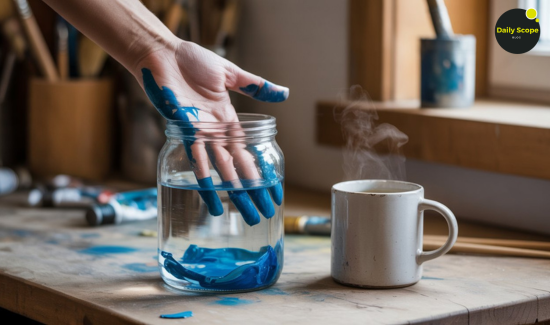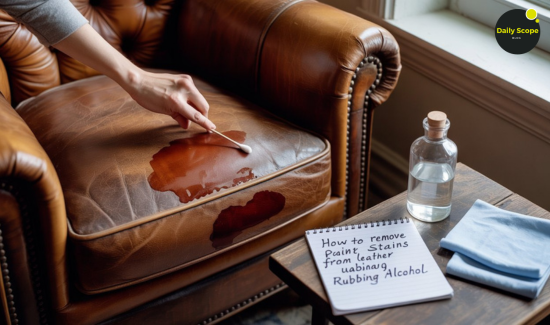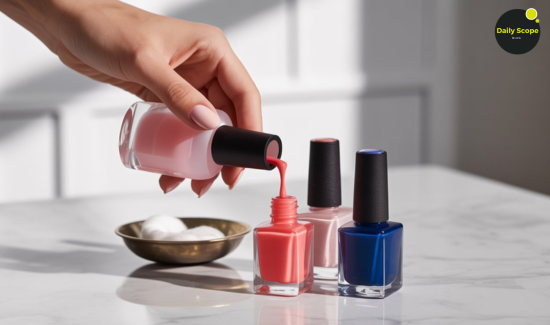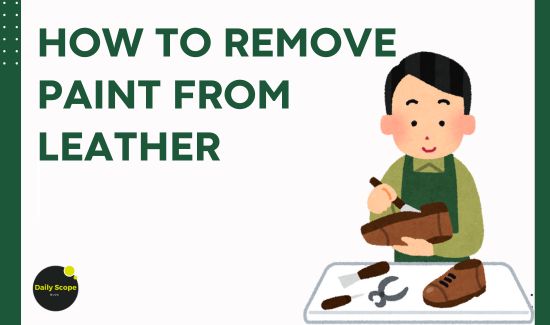When I first spilled paint on my favorite leather jacket, I panicked. It was one of those elegant, modern pieces that offered both warmth and style. The acrylic stains were stubborn and marred the surface badly. I had no idea where to turn and had tried everything else with no luck. After a bit of trial, error, and frustration, I found the right place—a method that didn’t require harsh solvents or permanent damage. So if you’re dealing with a leather item that’s been exposed to paint, especially something like shoes or a bag, here’s a helping hand based on real experience.
Begin by determining what kind of leather you’re dealing with. Every household probably has at least one piece of leather furniture, a journal, or accessories that can be easily stained. Using the right cleaning agent is essential. I once used the wrong cleaner, which almost permanently damaged my jacket. Now, I start by checking a hidden spot to make sure it doesn’t cause discoloration or harm the leather’s natural look. Then I apply a bit of cleaning agent with a cloth or sponge, gently wipe the painted areas, and repeat the process until the traces of paint are gone.
It’s important to treat the leather after cleaning. Use a conditioner to restore its original lustre and protect it from further damage. Also, avoid water, dust, and heat to help your leather stay in good condition. Cleaning should be done regularly, and never rush—minimum effort applied properly can go a long way. There are natural remedies and effective ways that work better than some of the more commonly used items on the market. It may be a daunting task, but with special attention, you’ll get rid of even the most annoying paint stains without ruining your leather.
Easy Oil Method to Clean Paint Off Leather
If you’ve ever accidentally spilled paint on your leather jacket or scuffed your leather shoes with a brushstroke, don’t worry—it’s a problem I’ve dealt with myself more times than I can count. One of the most effective tricks I use is simple cooking oil, like olive oil or even baby oil. These gentle oils can penetrate the surface and help remove oil paint, paint stains, or excess paint without damaging the leather. Just dip a cotton swab or cotton ball in oil, and with a light hand, wipe the paint slowly in a circular motion. Let it sit for a few minutes, and you’ll notice the stain start to break down.

To tackle stubborn spots, I often repeat the process, and if needed, I carefully scrape or draw at the edges using a dull knife—never anything too sharp. For tougher areas, mix a paste of baking soda and dish soap, and scrub the area gently with a toothbrush. Then wipe it off with a damp cloth to get rid of any leftover residue or mixture. A solution of vinegar and baking soda works well too, and helps get rid of excess oil. If there’s still color left behind, a touch of nail polish remover or rubbing alcohol can help dissolve the last bits. After everything’s removed, don’t forget to condition your leather with a leather conditioner to keep it soft and supple. I’ve used these simple steps on everything from leather boots to my favorite accessory and have always managed to clean the leather without harm.
A Simple Way to Lift Paint Using Warm Water
When I first had to remove a stubborn paint stain from my favorite leather item, I thought I’d ruined it forever. It was a splash of water-based wet paint that dried quickly, and I panicked. But after years of working with leather and a few mistakes along the way, I learned that the easiest way and one of the simplest ways to deal with such accidents is using warm water—yes, something as basic as that.
Here’s the method I’ve used with great success: First, grab a clean soft cloth or damp cloth, dip it into warm water or hot water, and gently rub the stained area. You can also fill an empty spray bottle with warm water, spray it over the spot, and let it saturate the surface for about 20 minutes. For dried or harder-to-remove spots, this gives the stain enough time to loosen without needing a commercial solvent like acetone or rubbing alcohol, which can discolour or dry out sensitive surfaces. Be sure to act quickly and with discretion if you’re unsure whether you’re dealing with oil-based paints or acrylic leather paint.

If the paint stain doesn’t budge, use a butter knife to gently scrape the edge of the painted spot. Then, in a bucket, mix about 2 cups of warm water with 1/4 cup of mild dishwashing liquid until it forms foam. Dip just the foam onto a sponge and gently work it over the area using circular motions. Always use gentle pressure—you don’t want to damage the product. When the sponge gets dirty, rinse it under cold running water.
Once the stain lifts, wipe the area with a dry cloths or soft towel, then let it air-dry. Use a lint-free cloth to dab one to two drops of leather cleaner or conditioner, then buff the area gently to bring back its shine. That final touch not only reconditions the leather but also helps keep it from cracking after the cleaning process. If you usually buff your jacket or shoes with cloth, stick to that method for consistency.
This whole process is safe for minimalist leather sneakers, black shoes, or even Allen Edmonds and Oliver Cabell sneakers, especially when using trusted products like meltonian leather cleaner. Just be cautious when dealing with light colored paint, black pigment layer, or trying to fix coloring or dye. Whether it’s a boot, toe, or full leather surface, a little elbow grease and patience can make all the difference.
Cleaning Leather with Soap and Water
When trying to clean paint stains from leather, especially on furniture or a leather jacket, a simple soapy and water solution can be surprisingly effective. Start by filling a bucket with water and add a gentle soap powder or a gentler soap that quickly dissolves. Mix the solution thoroughly until a gentle layer of foam appears on top. This method works well on many leather items, including footwear and shoes.
Use a clean paper cloth and dip it in the soapy solution, then gently wipe the paint stain along the grain of the leather. Let me the solution sit for a few minutes to help loosen the paint. If the stain still persists, carefully dab a little hydrogen peroxide onto the spot using a cotton swab — this can help break down stubborn stains without harming the leather.

Once the paint starts to lift, wipe away any residue with a damp cloth, being careful not to rub too hard and damage the texture. After clean, it’s important to polish and condition the leather to restore its softness and shining. Apply a good leather conditioner onto the surface will protect it and keep it looking fresh.
From my experience, this Method 3 of using soap, water, and hydrogen peroxide is a gentle but effective way to clean paint off leather without risking damage. It’s a practical approach that works on everything from delicate leather jackets to sturdy shoes and furniture.
Using a Soft Bristled Brush for Cleaning
When dealing with paint on leather, using a soft-bristled brush can help remove loose paint particles without causing damage to the material. Start by mixing a gentle cleaning solution made from warm water and dish soap in a bucket. Dip the brush lightly in the soapy water and gently rub the paint stain in paper brush strokes along the grain of the leather. This method helps to loosen the paint pieces and debris safely without harsh scrubbing.

After the paint starts to lift, use a cleaning, dry cloth or a dry towel to carefully wipe away the residue. If some paint dots persist, you can repeat the process or use a natural brush cleaner to rinse the brush and avoid spreading dirt or mildew on your leather products. Following this cleaning routine weekly keeps your leather soft and free from dirt buildup. Once the paint is removed, apply a good leather conditioner to restore the softness and texture of the leather and maintain its durability for future use.
If the paint is dried or stubborn, it may require professional care or specialized products like nail polish remover or acetone,e used carefully, especially on black cream polish or colored leather shoes. But for most cases, gentle brushing with soapy water and patience is the safest and most effective way to keep your leather clean and well-conditioned.
How to Remove Paint Stains from Leather Using Rubbing Alcohol
When regular cleaning doesn’t lift the paint spot on your leather jacket, rubbing alcohol can be an effective option. Start by pouring about 1/2 cup rubbing alcohol into a small bowl and soak a cotton ball in it. Use a new cotton ball if the old one becomes soiled to avoid spreading dirt or old paint back onto the leather. Lightly work over the stained leather using circular strokes, concentrating on the paint without pressing too hard. This gentle method helps prevent issues like surface cracks or fading.

Once you have removed the paint, use a lint-free cloth dampened with cool water to gently wipe away any excess rubbing alcohol. It’s very important to be cautious because rubbing alcohol contains chemicals that can be harsh on leather. I’ve learned through experience that light pressure and avoiding heavy scrubbing are key to keeping the leather safe while still removing paint effectively. Begin by trying the cleaning solution on a hidden section of the leather to make sure it doesn’t cause any damage to the overall surface.
After the paint is gone and the leather has dried completely, applying a good leather conditioner will restore its softness and prevent it from drying out or cracking. This finishing touch is essential to keep your leather items looking their best after any cleaning process involving chemicals. Using a soft cloth to buff the surface afterward will also bring back its natural shine and smooth feel.
For stubborn stains, sometimes a little patience is required, but following this simple method with rubbing alcohol has helped me get it off without needing professional products or complicated treatments. Remember, always target the area carefully and use gentle movements to protect your valuable leather goods.
Using Fingernail Polish and Nail Polish Remover
When dealing with paint stains on leather, fingernail polish and nail polish remover can be surprisingly effective tools. Although fingernail polish is mostly known for nails, it can also help exfoliate and lift paint from leather surfaces. To start, use a cotton swab or cloth lightly dipped in nail polish remover and gently wipe the stain gently away. Be careful not to rub vigorously, as this might damage leather, especially since leather is a delicate material that can be ruined if handled roughly.
Use a clean paper towel or clean cloth to wipe off any remaining nail polish and avoid reintroducing paint by using multiple pieces if needed. This process works best if you avoid harsh rubbing because it can strip the leather’s surface. To help loosen paint stains and add moisture, applying Vaseline or petroleum jelly afterward is a great tip — this keeps the leather soft without the need to immediately condition leather.

It’s important to remember that leather comes in different grades and forms, and paints also vary, so always perform spot-testing on a hidden area before treating the entire stain. Doing some research or seeking advice from a professional cleaner can help ensure you take the proper action. If you own a valuable jacket or other leather goods, handling these stains with care is key to preserving their quality.
From my experience, gentle care and patience make all the difference when trying to remove paint safely. Using these household items carefully can fix stains on leather without harsh chemicals or damage. Just remember to test first, avoid aggressive scrubbing, and keep your leather moisturized after cleaning.
Using Petroleum Jelly to Remove Paint Stains
One of the popular ways to remove paint stains from leather products is by using petroleum jelly, like Vaseline. This method works well because the jelly helps to moisten and loosen paint stains without harming the leather itself. I have personally used this on my white leather jacket, and it required attention and care, especially because white leather items need a little more gentle handling to avoid discoloration.
To start, simply dab a small amount of petroleum jelly directly on the paint stain and let it sit for a few minutes. This allows the jelly to soften the stain, making it easier to scrape off with a dull knife or even your fingernail. Be careful to avoid using a sharp object that might damage the leather surface. After peeling off the loosened paint, use a soapy cloth to wipe away any excess paint and jelly residue.

For white leather items, I recommend using a white commercial leather cleaner after this process to fully clean the paint stain and restore the leather’s original look. This step ensures the safe removal of the stain and keeps your leather soft and well-conditioned afterward. The entire process is quite simple but requires patience to do it right and avoid any damage.
If you ever spill paint accidentally, this method is a great option to quickly and safely get rid of the stain without harsh chemicals. The key is to damp the stain lightly and let the petroleum jelly work its magic before you scrape off and clean the area. With this method, your leather can look fresh again without much hassle.
Using a Blunt Knife to Remove Paint
When dealing with a stubborn paint stain on your leather item, it’s important to act fast before the acrylic paint dries and becomes harder to remove. Start by gently using a blunt knife or dull knife scraper with light pressure to carefully lift off the dry paint without causing damage to the leather. For wet paint, first rinse with water and use a sponge to wipe away the remaining paint. If this doesn’t work, follow the advice to apply a commercial leather cleaner, making sure to spot-test the affected area beforehand. Always read and follow the instructions on these products, using a soft cloth to finish by wiping away excess fluid gently. This method requires patience but is effective when done right.
Using a Clean Wet Rag for Paint Removal
If you accidentally splatter wet paint on a leather object, the good news is that it can often be removed without major damage. The first step is to wait until the paint is fully dry, then take a clean cloth and carefully scrape off the paint. After that, use a wet cloth or a damp cloth to gently rub the area and remove tacky residue. You can add gentle suds of water and mild soap to the cloth for better results. Then, buff lightly with a dry cloth or dry rag to help finish cleaning the leather.

When dealing with wet paint, using a wet rag soaked in water and soap can help tackle the paint stain without harming the material. Just be careful to avoid excess moisture because it can cause the leather to become warped, distorted, or damaged by excess moisture. Make sure the surface is dry after cleaning — it might take a bit of time, but it’s important to keep the leather dry. For tougher stains, commercial leather cleaners made for furniture or car upholstery can break down and eliminate paint that regular cleaning can’t. Always take extra precaution by doing a spot-test on a hidden area before applying any product to the visible portion to ensure no further discolouration or damage occurs from its use.
Understanding Spot Testing
When dealing with leather, it’s important to remember it is a delicate material, and not every kind can be cleaned with a single method. That’s why spot testing is such an important process before you begin. Spot testing means applying your cleaning material on a small area first, preferably one that’s not visible to the eye, to make sure it is safe and causes no side effects like discoloration or damage. This critical step helps avoid any mess or unwanted difference on the leather material. Before you try to clean a stubborn paint stain or get rid of any paint, you should always make sure the product you use is right for your specific kind of leather. I’ve learned from experience that planning and testing carefully can save you from ruining your favorite leather items.
FAQs
1. Using Vinegar to Remove Paint
When it comes to removing paint from leather, many wonder if vinegar really works. While the idea might seem apocryphal, white vinegar mixed with equal parts water creates a gentle solution that can help. Start by dabbing a cloth in the mixture and gently rubbing the paint-stained area in circular motions. Let the vinegar sit for a few minutes to lift dirt and soften the paint from the natural fibers of the leather. Then, use a clean cloth to carefully wipe away the paint. This process may need to be repeated until the paint is removed. Always test vinegar on an inconspicuous spot first to ensure it won’t damage your leather item. Though there is little research on its full effectiveness, using vinegar this way is a safe and simple method to clean leather without harsh chemicals.
2. Can Paint Be Removed from Leather Seats?
Removing paint from leather seats depends on the type of paint and the severity of the stain. Some stains have a tight grip on the leather surface, requiring strong cleaning products or even a stronger solvent like acetone or lacquer thinner. In these instances, you may need to use a damp cloth with an oil-based cleaner and apply extra elbow grease to lift the paint. It’s important to test any cleaning product first on an inconspicuous area to ensure no further damage occurs. If the stain is stubborn, it’s best to contact a professional upholstery cleaner to avoid micro-aggressions or permanent damage to the leather. Combining the right products with careful technique can have a good impact in successfully removing even the toughest paint stains without harming the leather.
3. Using Rubbing Alcohol Safely
When you want to remove paint from leather, rubbing alcohol can be helpful if used carefully. First, always test the cleaning solution on a small inconspicuous area to avoid any unexpected damage. Use a clean cloth and gently rub the paint in a circular motion with light pressure—never scrub hard because it can damage leather. Once the paint is removed, use a damp cloth to wipe away excess rubbing alcohol. Then, allow the leather to dry completely before applying any conditioner or polish to keep the leather soft and protected. This method works well when done patiently and carefully, preserving your leather item’s look and feel.
4. Using Acetone Safely on Leather
When you need to remove paint from leather, acetone can be a very powerful solvent that helps break down chemical bonds in paint materials. From my experience, it’s important to work in a well-ventilated area and always test a small area first to make sure it won’t damage the material. If it’s safe, you can apply acetone to a cloth and rub gently over the painted area until the paint is removed. Afterward, rinse the acetone off with warm water and allow the leather to dry completely before you use it again to avoid any further harm.
5. What Dissolves Dried Paint?
When dealing with dried paint on leather, it’s important to choose the right solvents to safely remove paint without harming the material. For oil-based paints, mineral spirits or turpentine work as effective solvents to break down the stubborn paint. If the paint is latex, using water mixed with a mild detergent solution can help dissolve it gently. Sometimes, a stronger solvent like acetone or lacquer thinner is needed, but always take safety precautions when using solvents and test on a small area first. From my experience, picking the right type solvent based on the paint kind makes the cleaning process much easier and protects your leather from damage.
6. Using Paint Thinner on Leather
Using paint thinner can remove paint from leather, but it must be done cautiously because it is a powerful solvent that can damage leather if not used properly. From my experience, the first step is to test paint thinner on a small, inconspicuous area of the leather item to make sure it does not cause discoloration or that no damage occurs. If safe, apply a small amount of the thinner on a clean cloth and gently rub the stained area in a circular motion until the paint is removed. Then, wipe away any excess paint thinner with a damp cloth and let the item dry fully, completely before using again to avoid further harm.

1 thought on “Effortless Way to Remove Paint from Leather Fast”